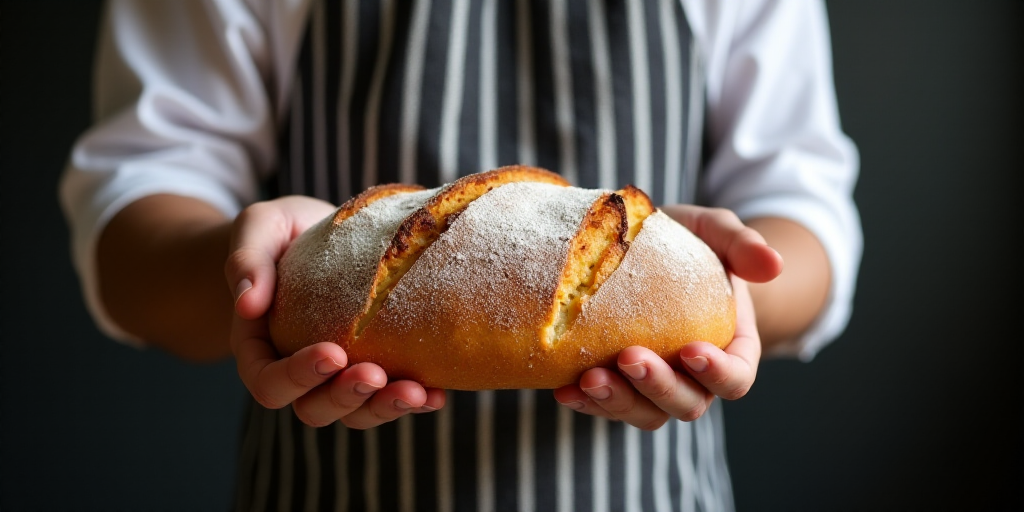The Rising Popularity of Sourdough Bread
Sourdough bread has gained significant popularity, with an increasing number of bakeries and retailers promoting it as a higher-quality, healthier alternative. But is this perception truly accurate?
While more rigorous, comparable studies are needed, existing research suggests that sourdough bread generally offers better digestibility, causes fewer blood insulin spikes, contains fewer harmful substances (such as phytic acid, acrylamide, gluten, or FODMAPs causing intestinal discomfort), is more filling, lasts longer, has a crispier texture, and boasts superior flavor. What contributes to these advantages?
Beyond proper baking techniques using high-quality whole grain flours and extended fermentation, the microbial community developed in sourdough starter plays a crucial role.
The Microbial Maestros: Yeasts, Lactic Acid Bacteria, and Acetic Acid Bacteria in Harmony
Creating a homemade sourdough starter is relatively simple. By mixing flour and water, leaving it in a temperate place, and daily feeding until it can double its volume and acidify, you’ll obtain what’s known as Type I sourdough starter.
During this process, various microorganisms present in the flour, water, hands, or environment multiply and dominate. These microorganisms are primarily yeasts, lactic acid bacteria, and acetic acid bacteria (in smaller quantities) that give sourdough bread its primary characteristics. These microorganisms are considered safe (QPS according to the European Food Safety Authority, EFSA) as they’ve assisted in bread-making for thousands of years.
The most common yeast found in sourdough starters is Saccharomyces cerevisiae, though different strains are used for bread compared to those in winemaking or commercial yeasts employed in industrial panification. Non-conventional yeasts like Kazachstania exigua or Kazachstania humilis are also present and adapt to this environment. They carry out alcoholic fermentation, converting flour sugars into carbon dioxide (which makes the dough rise) and ethanol, which evaporates during baking.
Fructilactobacillus sanfranciscensis (formerly known as Lactobacillus sanfranciscensis) is the primary lactic acid bacteria associated with sourdough starters, though other common ones include Lactiplantibacillus plantarum, Companilactobacillus crustorum, or Limosilactobacillus fermentum. These bacteria carry out lactic acid fermentation, converting flour sugars into lactic and acetic acids (responsible for the acidity of the dough), carbon dioxide, and ethanol. Acetic acid bacteria of the genera Acetobacter and/or Gluconobacter are present in smaller quantities, consuming ethanol and glucose to produce acetic and gluconic acids, respectively.
Close Relationships that Shape Flavor
The association of these three microorganism groups in sourdough starters results from the relationships they establish, leading to dominant combinations of individuals resistant to acidic environments, non-competitive for substrates, or mutually nourishing each other.
Other factors like flour type and quality, water, temperature, and environment also play essential roles, contributing to the great diversity of sourdough starters.
Nurturing Our Microscopic Companions
At home, with patience and consistency, you’ll obtain a robust sourdough starter ready for bread-making. If not used entirely, you’ll need to decide how to preserve it.
Refrigeration at 4 ºC is the simplest option, slowing microorganism activity but affecting them differently based on cold tolerance. Alternatively, freezing at -20 ºC allows longer preservation, though yeast viability will be lower.
In both cases, ensure microorganisms are viable before using the starter for bread by providing multiple feeding cycles and confirming their ability to leaven and acidify the dough.
Bakeries with their own Type I starters usually feed them daily for pan production but can also preserve them using the aforementioned methods.
Another option is purchasing starters from specialized companies that have developed more durable and manageable formats for preservation and distribution. The most common conservation method is freeze-drying the starter, turning it into powder that can be stored at room temperature for years. In this format (Type III), the starter is marketed as inactive and, while it imparts acidity, aromas, and flavors distinct from those of bread made with commercial baker’s yeast, it doesn’t provide the benefits of living microorganisms’ metabolic action on the bread dough.
Microbial Farming: A Tiny Scale
Creating a sourdough starter is a form of microbial “farming,” similar to other fermented foods like yogurt, cheese, olives, ham, sausages, wine, and beer. In all these cases, the microbial community is essential.
With sourdough bread, we benefit from what these microorganisms can accomplish (levitating the bread dough) and the metabolites they degrade (gluten, phytic acid, other proteins, sugars, etc.) and produce (vitamins, acids, amino acids, antifungals, etc.) to create a nutritious and healthy food that preserves well without the need for additives.
Consuming this bread essentially means having a “natural and living” microorganism laboratory at home or in the bakery, free of pathogens, that can accompany us throughout our lives.
Using sourdough for bread production also associates with the value of artisanal and traditional manufacturing, which allows sufficient time for obtaining a high-quality product. These processes typically use local and low-impact products.
In conclusion, sourdough bread exemplifies the vital role microorganisms play in our lives.






